Click here for Pests!
Contents
- Sooty Mould (caused by Pests)
- Powdery or Downy Mildew
- Collar Rot & Southern Blight
- Botrytis Blights (Grey Mould)
- Guignardia & Phyllosticta
- Cercospora
- Anthracnose & Leaf Spot Diseases
Need the answer to a specific plant query? Book a 1-to-1 video call with Joe Bagley, the website's friendly author, to overcome and address your niggling problem! Available on iMessage, WhatsApp, Facebook Messenger & more.
1. Sooty Mould
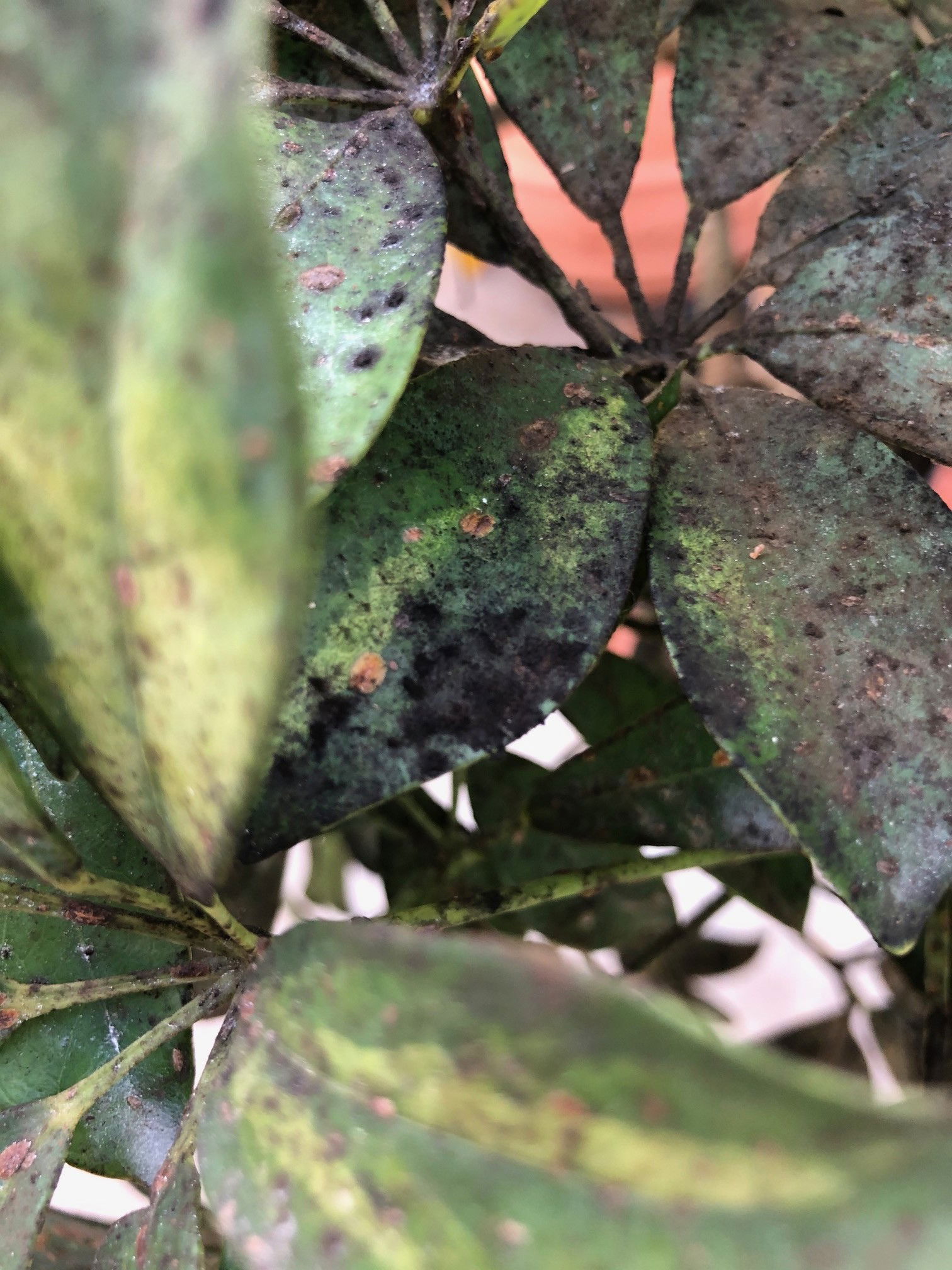 A severe infection of sooty mould, caused by Scale excrement.
A severe infection of sooty mould, caused by Scale excrement.
Symptoms - Black sticky fungus will form on the honeydew-excrements laid by scale, mealybugs and other pests. Although the mould won't directly affect the plant, untreated areas will cause the leaf's pores to block, resulting in slowed photosynthesis and a weakened specimen.
Causes - Fungi spores will land on the pest-excrements, forming into a widespread attack that can suffocate the foliage.
Action Needed
- Firstly, prune off the most hard-hit areas where the mould or pests are situated. All flowers and their shafts must be removed as mealybugs and scale like to burrow deep within their cubbyholes.
- Scrape off the mould and pests using either your fingernails or a blunt knife. As they'll be strongly attached on the foliage, just washing the leaves with a damp cloth won't be enough.
- Take the plant outside and gently spray with an outdoor hose. Focus on all of the plant portions above the soil line, especially where the pests will lay (underneath the leaves, in the flowers, etc.). Eradicating the pests, along with the thorough removal of the mould, will immediately destroy the backbone of the infestation.
- Once the plant is dry, spray the plant with either an organic or chemical-based pesticide. ukhouseplants would recommend the latter, due to the high chance of another attack - Provanto Ultimate Bug Killer will work immediately after the first application. For those who seek an organic version, Neem Oil is a great example. The berries of Azadirachta indica is farmed for its pest-eradicating scent that'll kill and deter any pre-existing or future infestations.
- For both options, hose the plant down every seven days and then spray the foliage with the chosen pesticide (following the manufacturer's guidelines). If it's only meant to be administered fortnightly, maintain washing the foliage each week as an organic way of keeping the population controlled. Getting rid of the pests will result in a reduction and eventual eradication of the sooty mould. Remove any further debris or seriously affected leaves and always keep it away from other specimens until the symptoms have cleared up for over a month.
2. Powdery or Downy Mildew
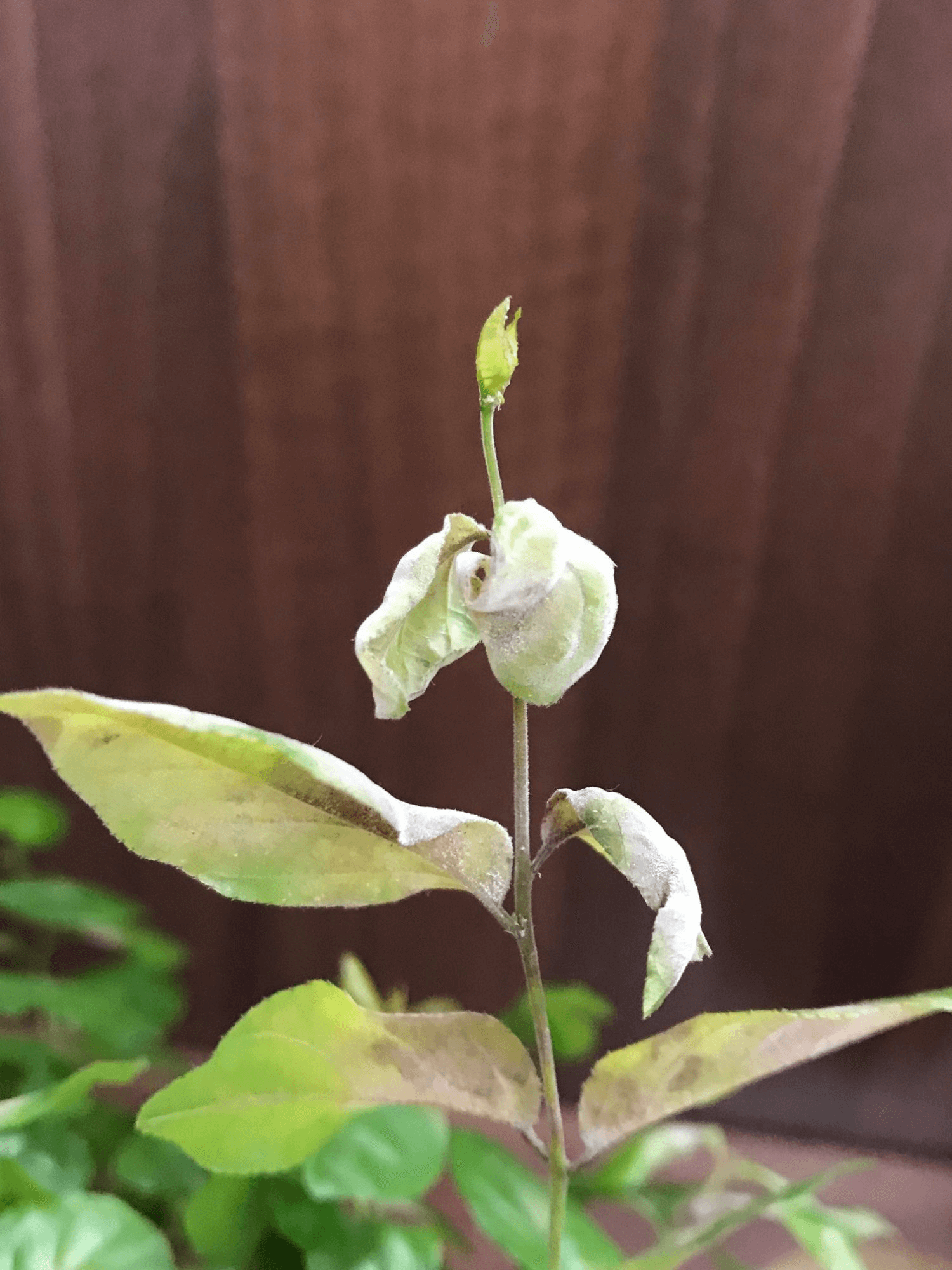 Powdery Mildew attacking the new growth of a Bonsai Tree.
Powdery Mildew attacking the new growth of a Bonsai Tree.
Symptoms - Clear, visible damage attacking the new growth. Symptoms - Mildew is a fine white powder that can affect any plant part above the soil line. More severe cases could allow leaves/stems to become yellow along with stunted new growth. Powdery mildew is most likely to attack dehydrated and/or unfertilised specimens.
Causes - Poor air circulation, high humidity and excess of moisture sitting on the leaves or flowers.
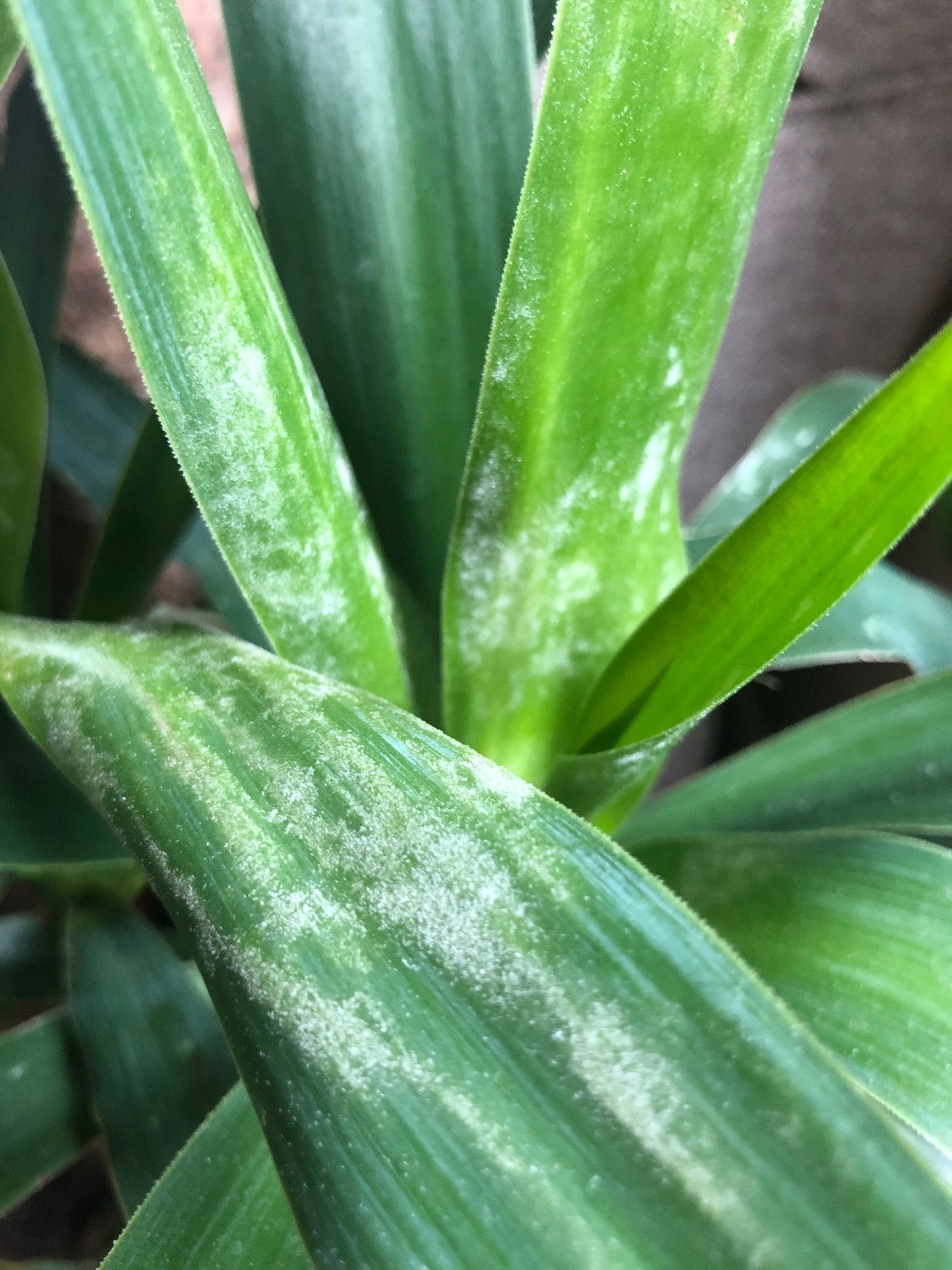 Powdery Mildew attacking the foliage of a Yucca elephantipes.
Powdery Mildew attacking the foliage of a Yucca elephantipes.
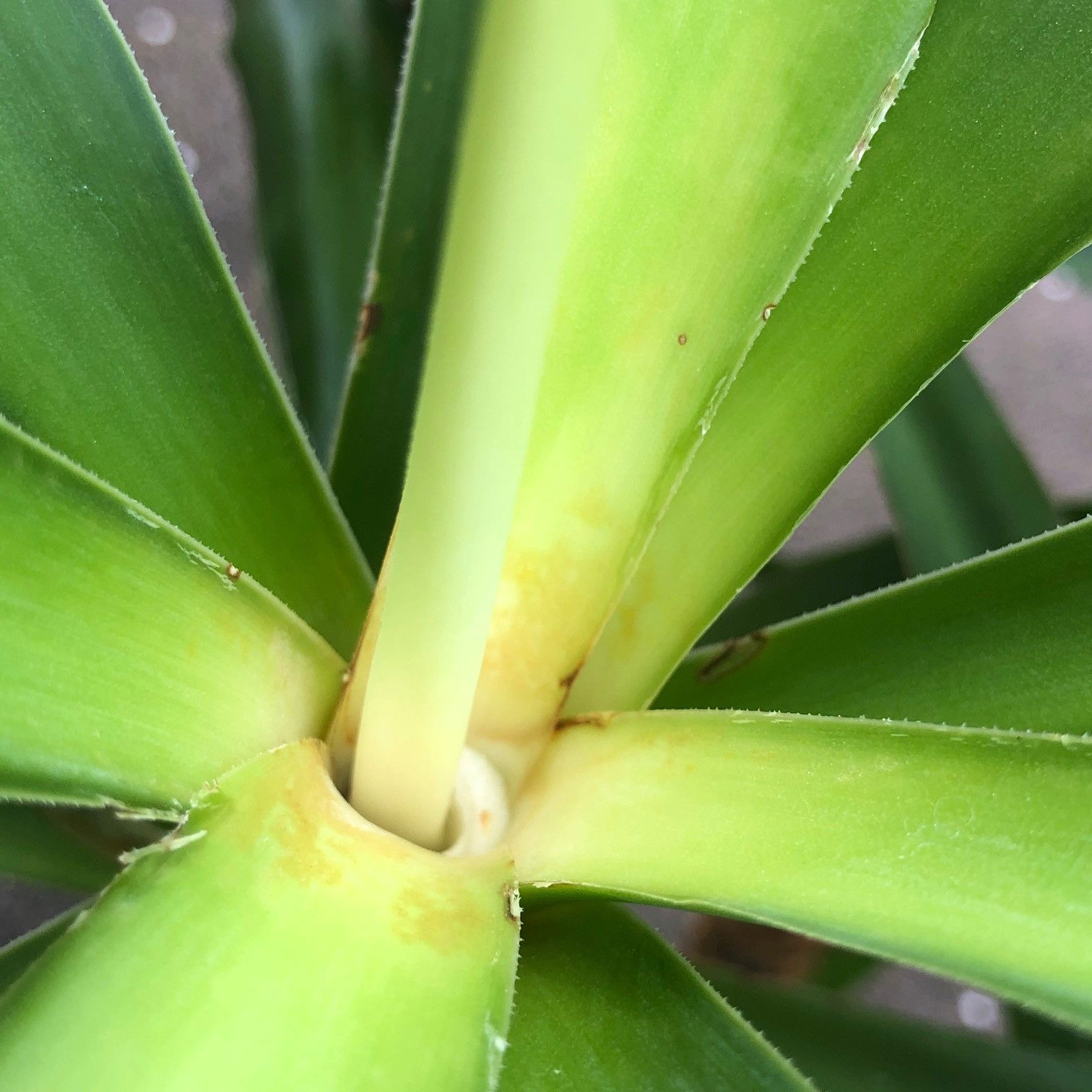 After wiping the foliage to eradicate the mildew, you'll begin to see the extent of the damage. Severe cases will see the curling of leaves and browning leaf-sections
After wiping the foliage to eradicate the mildew, you'll begin to see the extent of the damage. Severe cases will see the curling of leaves and browning leaf-sections
Action Needed
- Remove the severely affected leaves or flowers that house the 'heart' of the disease. Wipe the plant with a cloth of soapy water to remove the thin layer of powder, especially in the foliage's cubbyholes.
- Chose between using either an organic or chemical-based fungicide. (listed below)
- Spray the foliage in concordance to the recommended dosage (weekly/fortnightly, etc.).
- Wash the plant down using a damp cloth before each time you come to respray the foliage with a fungicide - this will fortify the eradication process immensely.
- Maintain a hygienic environment by discarding any fallen debris or severely affected areas. Keep an eye out for further development, taking appropriate action if necessary.
- Keep the plant out of direct sunlight or in an overly humid environment during recovery.
- Never situate it within two metres of another unaffected specimen until the symptoms have been eradicated for over two weeks.
- The chance of eliminating this form of mildew is very high, so don't discard the plant unless it fully dies.
Organic Fungicides
Neem Oil is the best option as it'll work after the first application. Dilute the oil with the appropriate part of water, and finely mist the foliage once a week for the next month. Keep the plant in a dry, bright location away from other specimens until the attack has been eradicated. Wipe down the leaves with a damp cloth when any symptoms arise.
Insecticidal, or Horticultural Soap is the second most used organic remedy on the market, with three versions to choose from. The first option is via purchasing an RTU (ready-to-use) spray bottle, which can be immediately used on the plants. Although most garden centres will stock this, it's far more economical to purchase the second option - concentrated bottles. This method comes with pro's and con's but is far cheaper to use if you have multiple infestations as you'll only have to use a set amount each application.
The last option is making it yourself. There are three ingredients in creating your own soap - a vegetable, tree or nut-based oil, non-fragrant dishwashing soap and tap water. Most oils are acceptable, with the most successful being vegetable, sunflower and olive oil. Add two parts oil, one part dishwashing soap and eight parts water to create the dilution. Spray the dilution wholly around the plant, empathising the hard-hit areas. This method should be performed weekly over the next month, along with regular inspections - as soon as you see a symptom, address it!
Using Milk or Baking Soda is another excellent example of an organic remedy. Mix 1 part of milk/soda with 4 parts water and use a cloth to remove the mildew. Again, provide a dry environment while the plant is recovering and keep the foliage unsaturated at all times. Re-introduce to others once the problem has been dissolved.
Chemical-Based Fungicides
For those seeking a healthier option, FungusClear Ultra is a great example. Not only is it widely available at most garden centres, but it's also relatively cheap and can be used on many different forms of fungi. Always read the label and follow the recommended guidelines for application.
- Provanto Fungus Fighter is another good option. Most centres will sell this in an RTU (ready-to-use) form, meaning that no dilution is necessary. Again, always read the label and follow the recommended guidelines to avoid damaging the plant.
Book a 1-to-1 Call with Joe Bagley
Need further advice with a wounded houseplant? Book an advice call with ukhouseplants' friendly and expert writer today to discuss your specimen's symptoms and how to address it!
3. Collar Rot or Southern Blight
Symptoms - The rapid loss of lower-leaves accompanied by root or pseudobulb rot. The stated plant parts will initially transition from a creamy yellow colour to a brown mushy appearance after a few weeks. White fungal growth can sometimes also be seen on stems when grown in an overly humid environment with poor air circulation. This disease is within the leaves and therefore, cannot be 'scratched-off'.
Causes - Excess moisture in between the leaves and the plant's body. Poor air circulation, high humidity levels and high temperatures could all accelerate the progression.
Action Needed
- Remove the severely affected leaves and discard any foliar debris that lay on the soil line below.
- If a large proportion of the roots have broken down, click on this link to learn about root rot and how to address it.
- Unfortunately, the spraying of fungicides will do nothing to help this disease. Hydrogen Peroxide is the closest product to help keep this issue under control, as it aids a more oxygenated-soil that'll assist the plant in developing a stronger root system.
- For every three irrigations, incorporate a splash of the peroxide to administer the oxygen - you'll have to do this at least three times to stop the chance of further rot and disease thoroughly. Always follow the manufacturer's recommended dosage, as chemical-burn is a common issue when over-used by gardeners.
- Situate the plant in a bright indirect setting away from other non-affected specimens. This disease will slowly fade away as time moves on; however, the already-affected leaves will never turn back to its former green appearance.
Images of Collar Rot
4. Mosaic Virus
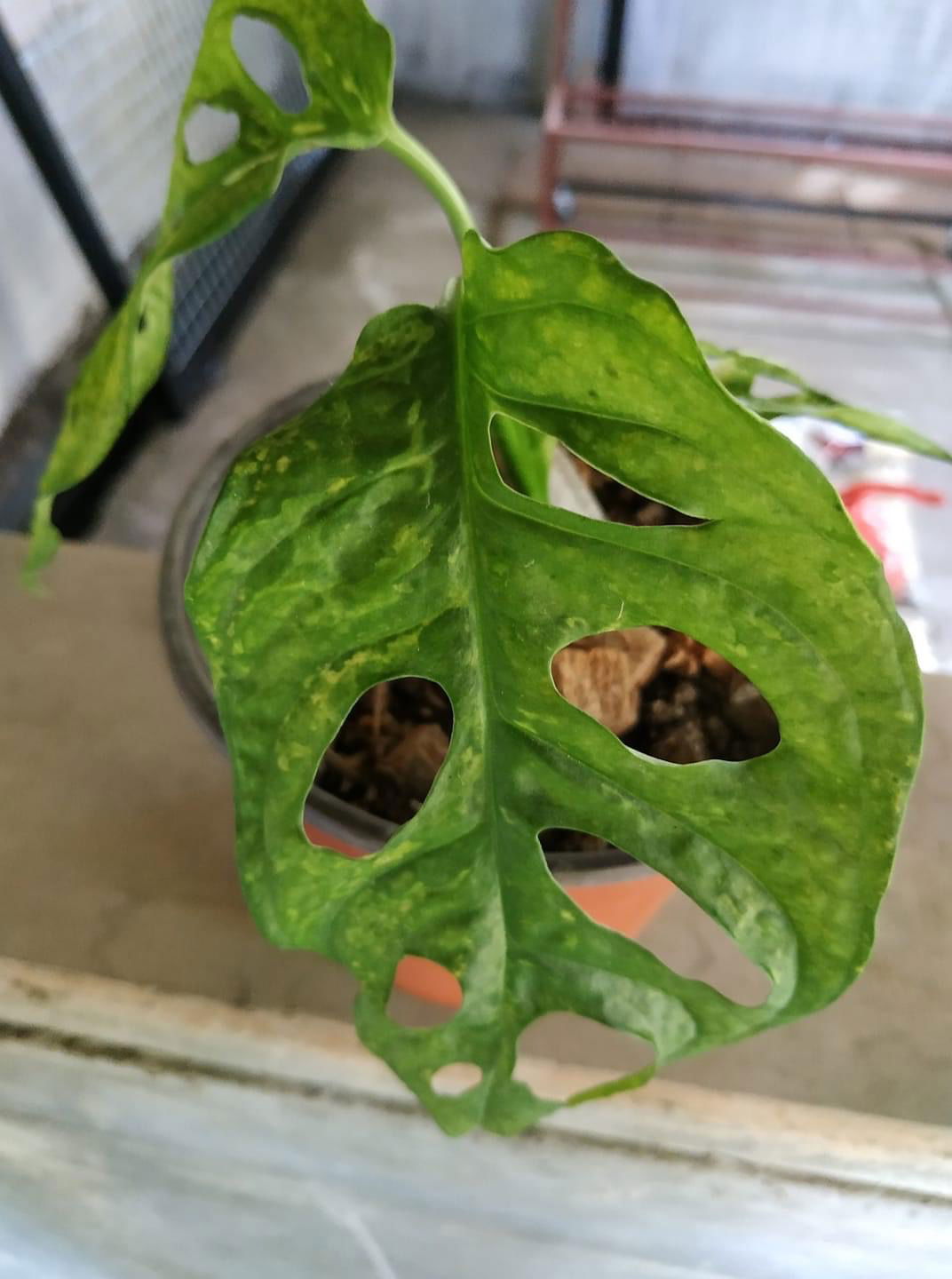 Mosaic Virus can affect Aroids, like Monstera and Philodendrons, & fruits Apples and Cucumbers.
Mosaic Virus can affect Aroids, like Monstera and Philodendrons, & fruits Apples and Cucumbers.
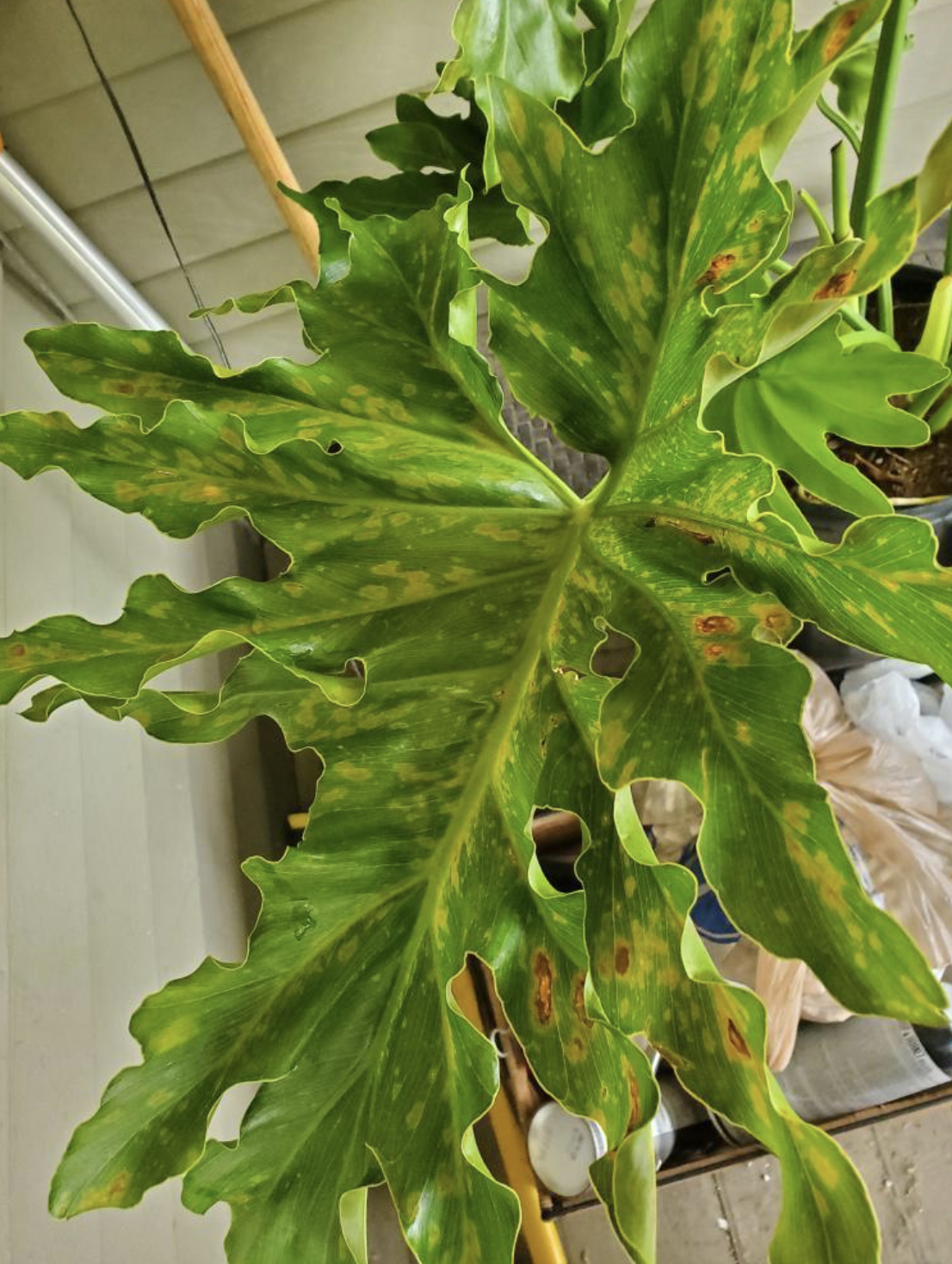 Another case of Mosaic Virus on a Philodendron selloum.
Another case of Mosaic Virus on a Philodendron selloum.
Symptoms - This virus is most likely to attack Monstera adansonii & M. obliqua (Monkey-Mask Plants), causing small, yellow lesions or patterns to on the leaves. At first, symptoms look similar to a nutrient deficiency or over-exposure to the sunlight, but as conditions worsen, you'll eventually find colonies of deeper affected areas.
Causes - The virus is usually pre-existent within the plant's cellular make-up, but some cases may arise from neighbouring plants. Other reasons include the multi-use of pruning scissors without being washed in between utilisation, re-using old potting mix, and pests that may spread from plant to plant, thus taking the virus with them.
Action Needed
- Inspect and remove any seriously-affected areas with a clean pair of scissors. Be sure to thoroughly wash the utensil afterwards with hot soapy water to avert a spread.
- Take the plant outside and perform a gentle hose-down. Although this won't directly remove the disease, it'll remove the thin layer of dust that will increase photosynthesis and therefore energy production. Repeat this step monthly.
- Cast an eye over the plant for further development, removing any affected areas or fallen debris as you go.
- Quarantine the specimen at least 50cm (almost 2ft) from other plants and try to segregate accessories (watering cans, etc.).
- Unfortunately, there are no known products that can wholly remove this disease. It'll be highly unlikely to eradicate this problem, so keeping maintained control and regular feeds will help contain the disease.
- Supplement using a nitrogen-based fertiliser ('houseplant'-labelled feed) to help the development of new, disease-free growth. This will help the production of photosynthesis that'll promote stored energy within the plant, thus giving it the best chance of survival. If you have a newly-purchased specimen, be sure to contact the store or grower to make them aware of the virus, as this is most likely affecting other customers.
 A final case of the virus on a Monstera adansonii.
A final case of the virus on a Monstera adansonii.
5. Botrytis Blight - Grey Mould
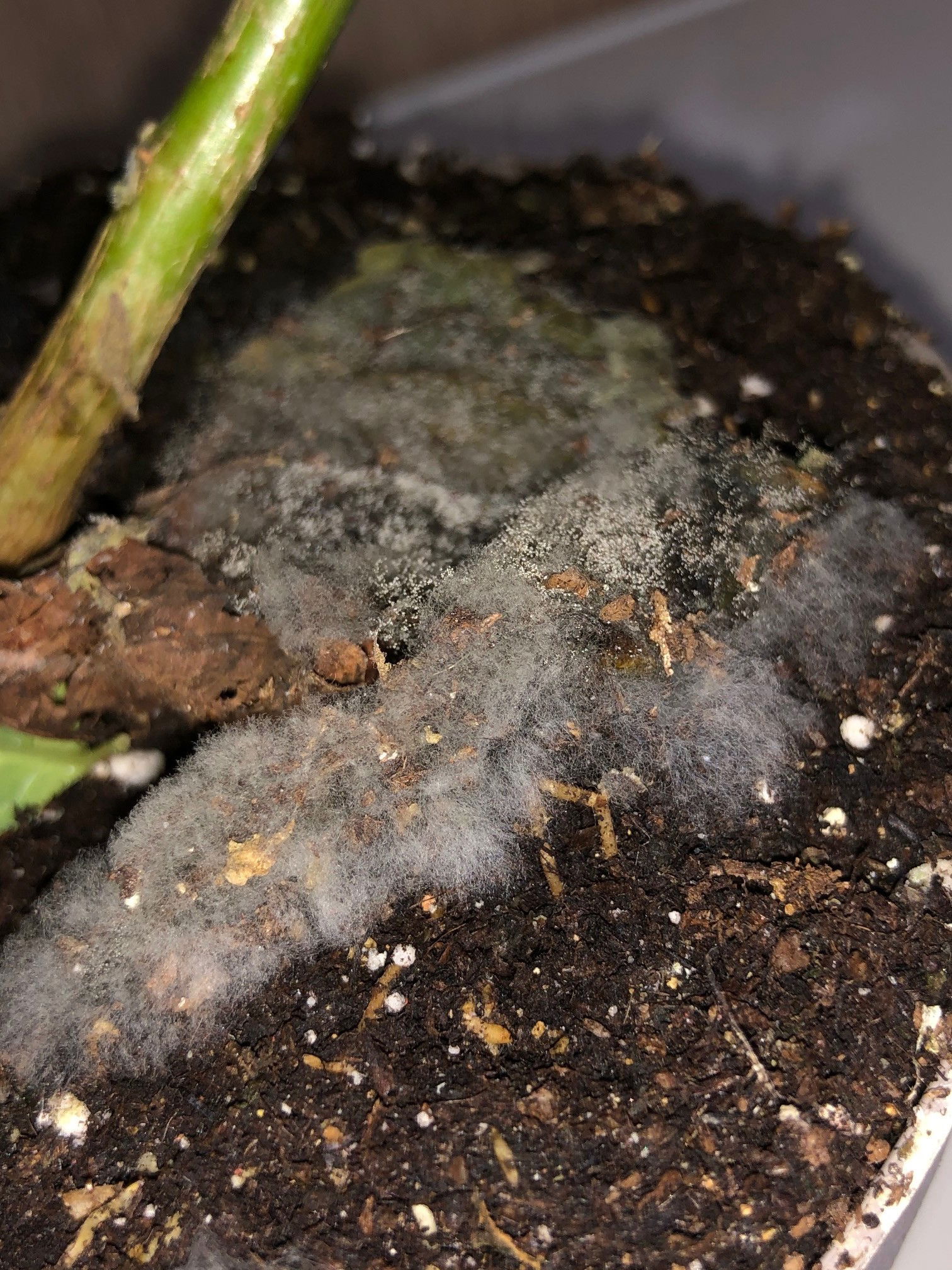 Grey Mould
Grey Mould
- Symptoms - Botrytis has two main disguises that'll attack either the flowers or the foliage. Small black or orange spots will develop on the flowers, while small yellow lesions (spots and elongated streaks) will engulf the leaves. Diseased debris will fall onto the soil line, causing it to mould-over and become highly infectious (pictured above).
 Botrytis Petal Blight on a Primula obconica.
Botrytis Petal Blight on a Primula obconica.
Causes - An excess of moisture on, and around the flowers or foliage. Poor air circulation, high humidity levels and dark locations may accelerate symptoms.
Action Needed
- Immediately remove any infected leaves or flowers using a sterile pair of scissors. It's important to prune off and remove the infections (or fallen debris) as the disease can quickly spread across its host and neighbouring specimens.
- Take the plant outside and perform a gentle hose-down. If needed, wash the leaves using a damp cloth with warm water beforehand to gain access to the leaf's surface.
- Spray the foliage wholly using a fungicide - we'd recommend using Provanto Fungus Fighter as it has excellent reviews and will get to work after the first application.
- Wash the foliage down with an outdoor hose before each administration of the fungicide.
- If the nighttime temperatures are above 15℃ (59℉), locate it outside for at least a week in a sheltered location. If it's too cold for this option, situate the plant in a well-lit area away from other unaffected specimens and direct sunlight.
- Remove any further debris or seriously affected leaves and always prevent saturating the plant's foliage. Once the symptoms have cleared for over three weeks, you may re-introduce it back into the home with other plants.
- Provide nourishment of nitrogen (general plant food is accepted) to help the development of new, disease-free growth.
6. Guignardia & Phyllosticta
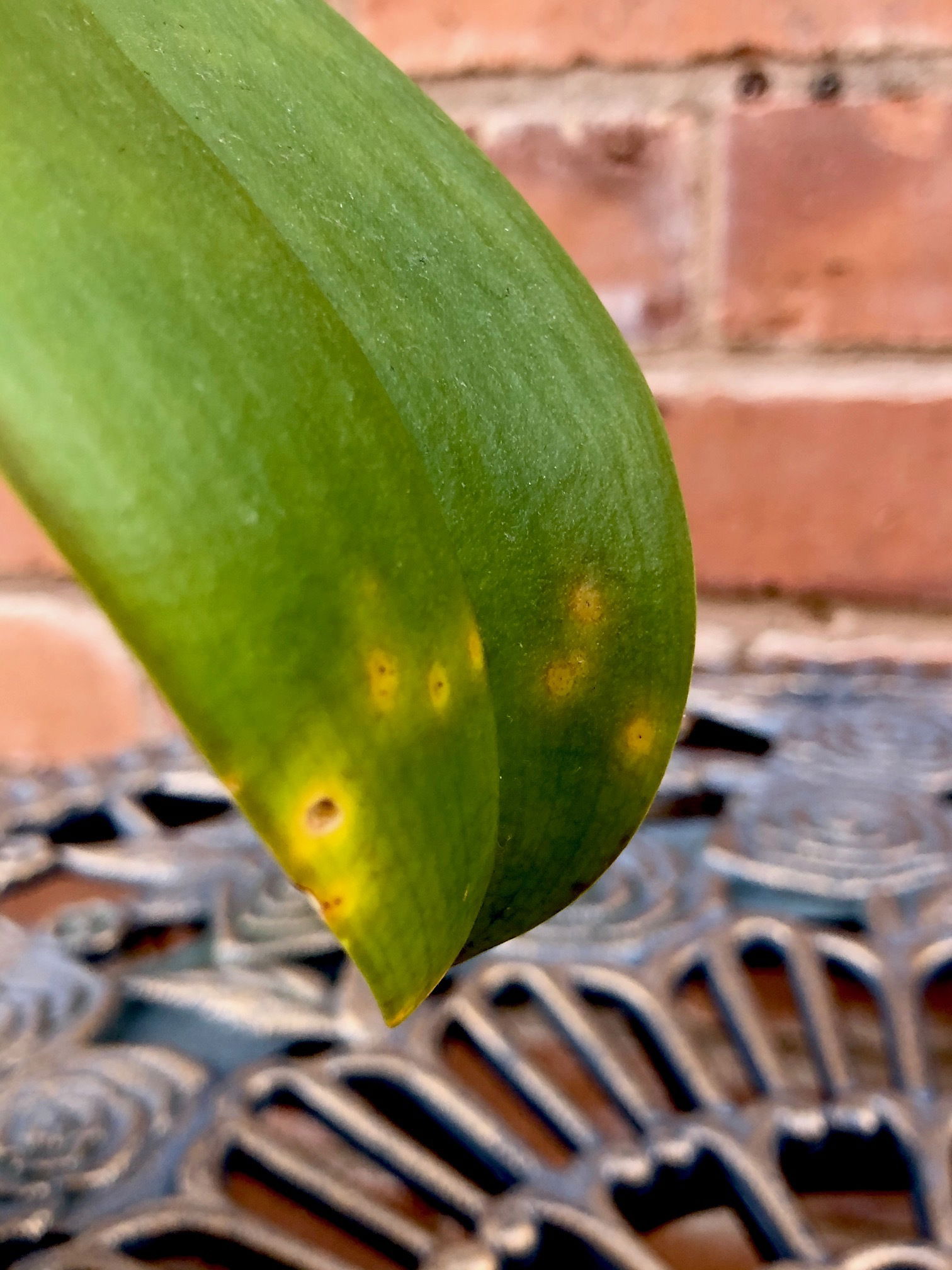 Phyllosticta on a Moth Orchid
Phyllosticta on a Moth Orchid
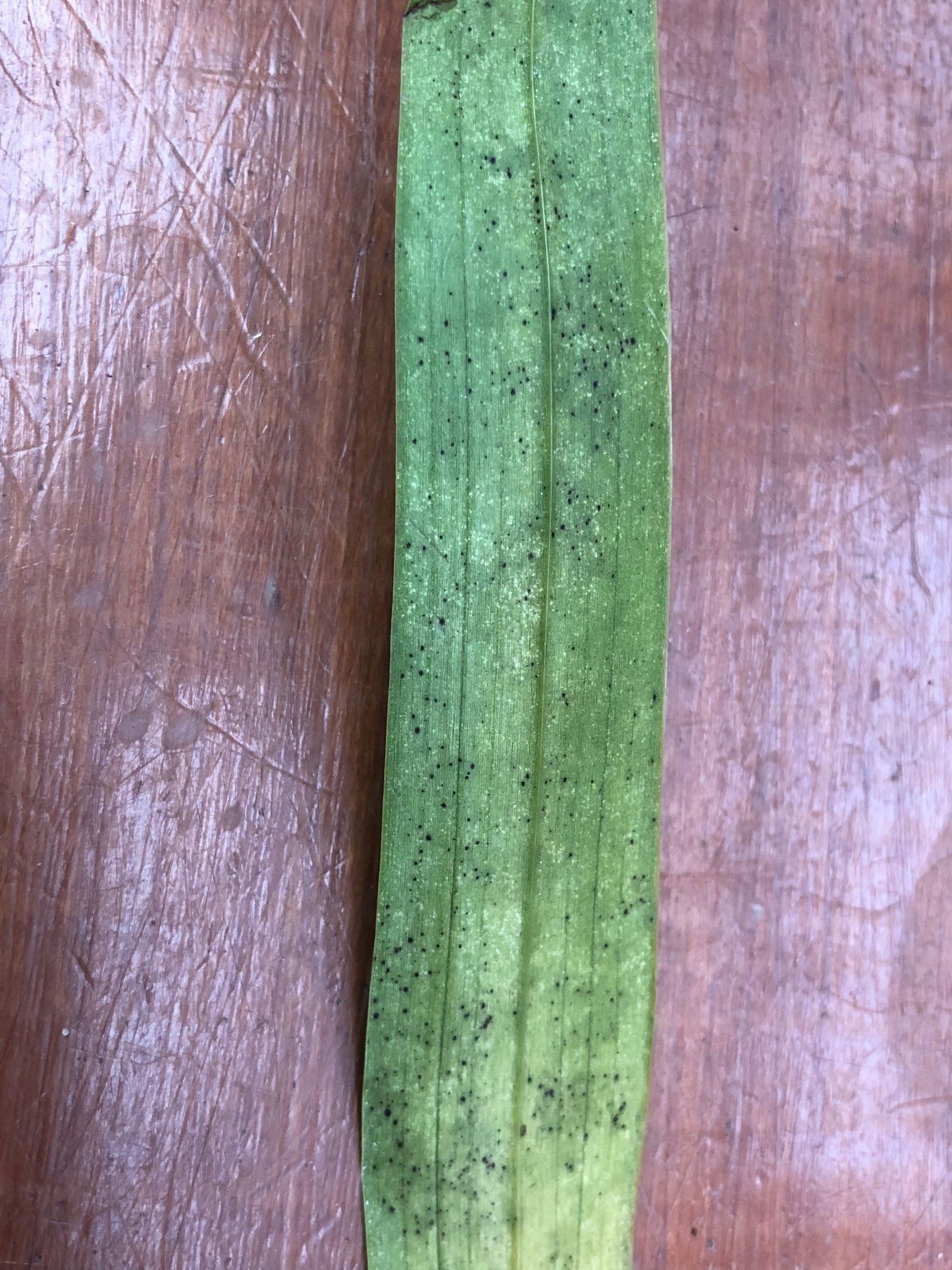 A small development of Phyllosticta and Spider Mite damage (white lesions) on a Cymbidium.
A small development of Phyllosticta and Spider Mite damage (white lesions) on a Cymbidium.
Symptoms - Small, yellow patches will develop into purple or transparent lesions (spots or streaks) on the leaves. Severe cases will develop raised sandpaper-like bodies along with the affected areas.
Causes - Poor air circulation and excess of moisture on the leaves, typically accelerated by low light.
Action Needed
- Inspect and remove any seriously-affected areas with a clean pair of scissors.
- Take the plant outside and perform a gentle hose-down. Although this won't directly remove the disease, it'll remove the thin layer of dust that will increase photosynthesis and energy production. Repeat this step monthly.
- Cast an eye over the plant for further development, removing any affected areas or fallen debris as you go.
- Keep it in a non-planted room as the spores may land on neighbouring plants, causing a further outbreak.
- Unfortunately, there are no known fungicides that can eradicate this disease - Provanto Fungus Fighter may help deter the disease's development, but this would be at the owner's risk. It'll be highly unlikely to eradicate this problem, so keeping maintained control would help mask the disease and keep the plant strong.
- Supplement using nourishment of nitrogen (general plant food is accepted) to help the development of new, disease-free growth.
More Images of Guignardia & Phyllosticta
7. Cercospora
Symptoms - Yellow spots on the underside of the leaf will slowly make their way through to the top after a few weeks. As they enlarge in irregular patterns, they'll become slightly sunken and will sport a purplish-brown appearance. Leaf loss will occur with infections close to the node (growth junction). One of the main differences between this disease and the one above is that Cercospora is usually more mottled and lighter in colour.
Causes - Poor air circulation and excess of moisture on the leaves.
Action Needed
- Unfortunately, there are no known fungicides that can wholly eradicate Cercospora, so other methods are essential to suffocate the symptoms. Remove any seriously-affected areas with a clean pair of secateurs or scissors.
- Take the plant outside and gently hose the plant down - although this won't directly attack the disease, it'll remove the thin layer of dust from the foliage, thus increasing photosynthesis and energy production.
- Situate the plant in a bright, indirect location with the correct cultivation requirements (i.e. watering, humidity, fertilisation & the monthly wash of leaves) to strengthen the plant's overall health.
- Cast an eye over the plant for further development, removing any affected areas or fallen debris as you go.
- Keep it in a non-planted room as the spores may land on neighbouring plants, causing a further outbreak. Unfortunately, it'll be highly unlikely to eradicate this problem, so keeping maintained control would help mask the disease and keep the plant healthy.
- Provide nourishment of nitrogen (general plant food is accepted) to help the development of new, disease-free growth.
Images of Cercospora
8. Anthracnose & Leaf Spot Diseases
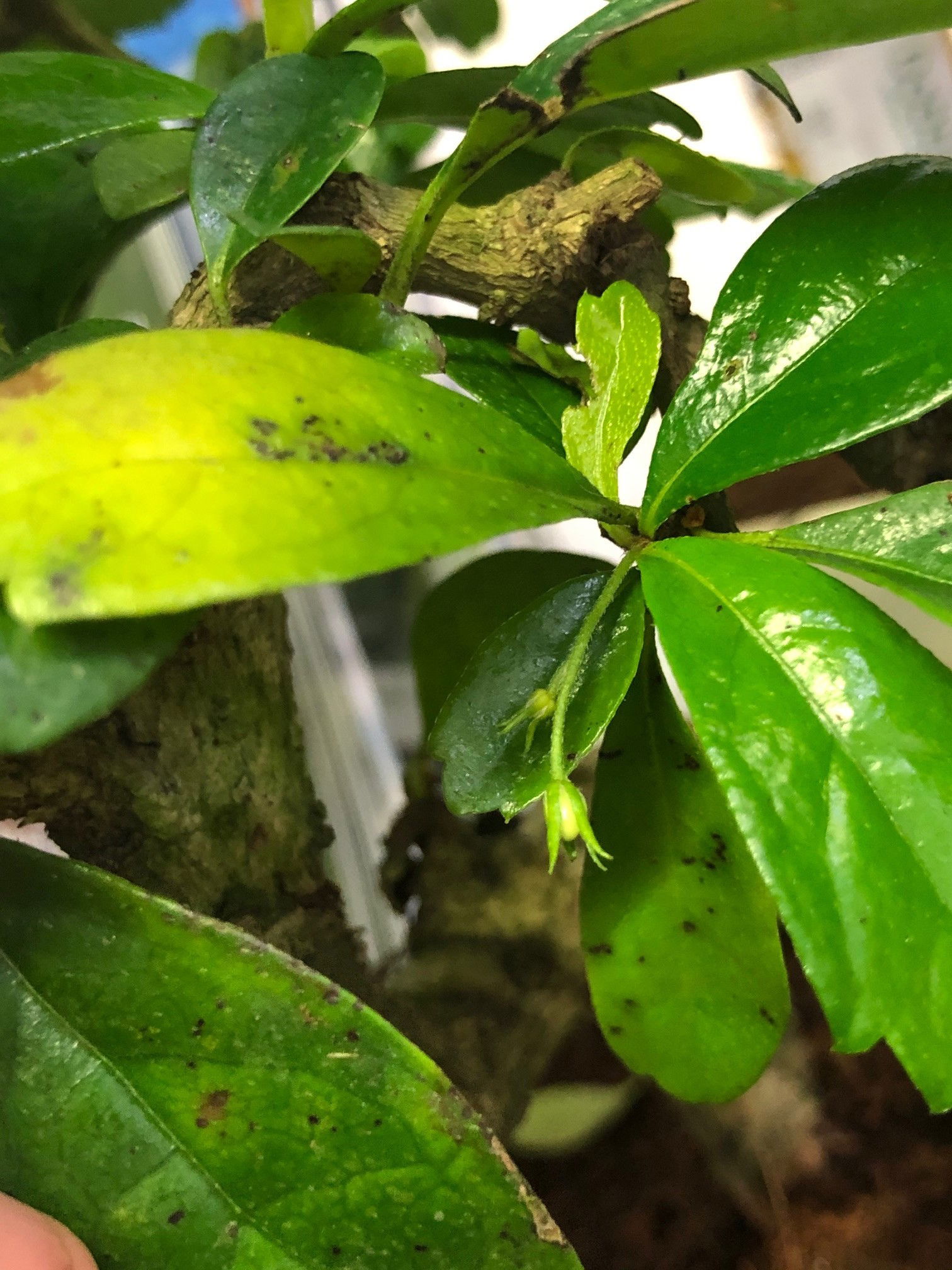 Black Spot Disease
Black Spot Disease
Symptoms - Brown, orange or yellow spots will slowly move spread across the leaves, sometimes accompanied by dark circular bands on the lesions.
Causes - Poor air circulation, excess of moisture on the leaves and high levels of temperature or humidity. This disease can sometimes go hand-in-hand with over-watering and root rot.
Action Needed
- Remove the severely affected leaves and always discard fallen debris that lay on the soil line below.
- Gently wash the plant using an outdoor hose before applying a fungicide. We'd recommend using a product that contains Chlorothalonil as this will protect the plant from a future attack. Other fungicides will, of course, aid the eradication of the disease, but this chemical is the best option. Follow the manufacturers' recommended dose, and wash the leaves regularly to remove any dust particles that will suffocate the plant. A dirt-free plant will photosynthesise and respire better, thus resulting in more energy produced to combat the disease.
- Remove any further debris or severely affected areas to relieve its symptoms. Keep it away from other specimens to prevent a further outbreak.
- As the already-affected areas won't turn green again, providing nourishment of nitrogen (general plant food is accepted) will help the development of new, disease-free growth.
Images of Anthracnose
Book a 1-to-1 Consultation with THE HOUSEPLANT DOCTOR™
Need realtime advice for a diseased houseplant? Book a video or message consultation with expert Joe Bagley, THE HOUSEPLANT DOCTOR™ (author or ukhouseplants.com). Choose between a ten or thirty-minute session & a platform of your choice (WhatsApp, FaceTime, Facebook Messenger or Zoom). Ask unlimited questions in one session, including queries on your dying/challenging plants, pests eradication, terrariums, repotting advice & everything in between! Available worldwide.